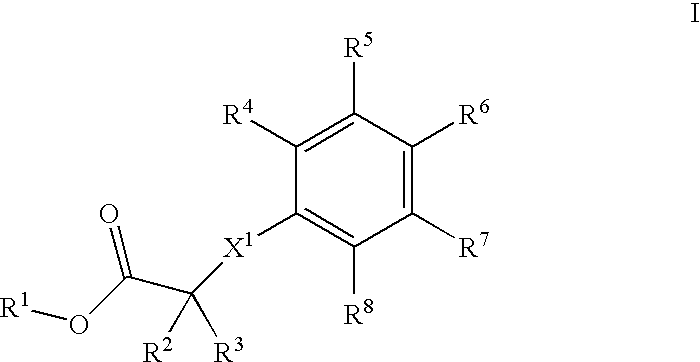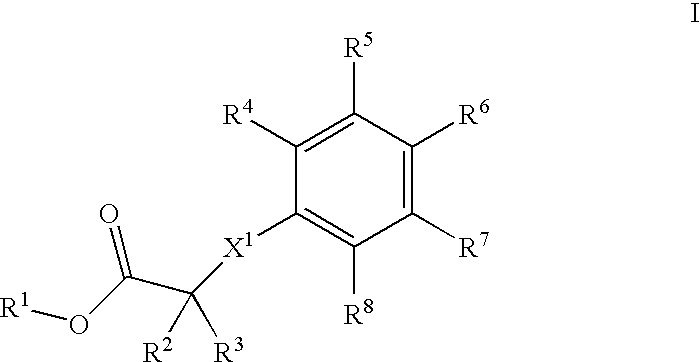Phenyl derivatives, their manufacture and use as pharmaceutical agents
a technology of phenyl derivatives and derivatives, applied in the field of phenyl derivatives, can solve the problems of limiting the therapeutic potential of this approach, unphysiologically high levels, and ultimately decreasing, and achieve the effects of reducing the requirement for exogenous insulin, restoring blood glucose and triglyceride levels, and moderate complian
- Summary
- Abstract
- Description
- Claims
- Application Information
AI Technical Summary
Benefits of technology
Problems solved by technology
Method used
Image
Examples
example 1
(2-(3-Methoxy-propyl)-4-{methyl-[2-methyl-6-(4-trifluoromethyl-phenyl)-pyridin-3-ylmethyl]-amino}-phenoxy)-acetic acid
A] (2-Iodo-phenoxy)-acetic acid ethyl ester
[0382] 9.10 g (41.4 mmol) of o-iodophenol was dissolved in 102 ml of acetone and treated subsequently at 0° C. with 14.8 g (1.1 eq.) of cesium carbonate and 4.57 ml (1.0 eq.) of ethyl bromoacetate. After vigorous stirring for 1 h at ambient temperature and filtration, the bulk of solvent was evaporated and the residue redissolved in AcOEt. Washing with water, drying over magnesium sulfate, and evaporation of the solvents finally produced 12.66 g of pure title compound as colorless oil.
[0383] MS: 306.0 (M)+.
B] [2-(3-Methoxy-prop-1-ynyl)-phenoxyl-acetic acid ethyl ester
[0384] A three neck reaction flask was successively charged with 12.65 g (41.3 mmol) of the above prepared (2-iodo-phenoxy)-acetic acid ethyl ester, 128 ml of acetonitrile, 5.793 g (2 eq.) of 3-methoxy-1-propyne, 17.28 ml (3 eq.) of NEt3, 1.45 g (0.05 eq.) ...
example 2
(2-(3-Methoxy-propyl)-4-{methyl-[2-methyl-6-(3-trifluoromethyl-phenyl)-pyridin-3-ylmethyl]-amino}-phenoxy)-acetic acid
A] 3-Chloromethyl-2-methyl-6-(3-trifluoromethyl-phenyl)-pyridine
[0410] was prepared in analogy to example 1N], but starting the whole reaction sequence with 3-(trifluoromethyl) acetophenone instead of 4-(trifluoromethyl) acetophenone, as white crystals of mp. 73-75° C.
[0411] MS: 285.1, 287.1 (M)+.
B] (2-(3-Methoxy-propyl)-4-{methyl-[2-methyl-6-(3-trifluoromethyl-phenyl)-pyridin-3-ylmethyl]-amino}-phenoxy)-acetic acid
[0412] The title compound was prepared in analogy to example 1, but using in step I] 3-chloromethyl-2-methyl-6-(3-trifluoromethyl-phenyl)-pyridine instead of 3-chloromethyl-2-methyl-6-(4-trifluoromethyl-phenyl)-pyridine, as light brown viscous oil.
[0413] MS: 501.1 (M−H)−.
example 3
[rac]-[2-(3-Methoxy-propyl)-4-(methyl-{1-[2-methyl-6-(3-trifluoromethyl-phenyl)-pyridin-3-yl]-ethyl}-amino}-phenoxy)-acetic acid
A] 2-Methyl-6-(3-trifluoromethyl-phenyl)-pyridine-3-carbaldehyde
[0414] 3.00 g (11.2 mmol) of [2-methyl-6-(3-trifluoromethyl-phenyl)-pyridin-3-yl]-methanol (synthesized as described in example 1K]-M], but starting with 3-(trifluoromethyl) acetophenone instead of 4-(trifluoromethyl) acetophenone), was dissolved in 56 ml of CH2Cl2 and treated with 14.6 g (15 eq.) of MnO2. After vigorous stirring for 2 h at ambient temperature, the reaction mixture was filtered over Celite and carefully rinsed with CH2Cl2. Evaporation of the solvent left 2.659 g of the title compound as white crystals of mp. 61-63° C.
[0415] MS: 266.2 (M+H)+.
B] [rac]-1-[2-Methyl-6-(3-trifluoromethyl-phenyl)-pyridin-3-yl]-methanol
[0416] 0.500 g (1.89 mmol) of the above prepared 2-methyl-6-(3-trifluoromethyl-phenyl)-pyridine-3-carbaldehyde was dissolved in 9.4 ml of abs. THF and treated at −1...
PUM
| Property | Measurement | Unit |
|---|---|---|
| temperature | aaaaa | aaaaa |
| temperature | aaaaa | aaaaa |
| temperature | aaaaa | aaaaa |
Abstract
Description
Claims
Application Information
 Login to View More
Login to View More - R&D
- Intellectual Property
- Life Sciences
- Materials
- Tech Scout
- Unparalleled Data Quality
- Higher Quality Content
- 60% Fewer Hallucinations
Browse by: Latest US Patents, China's latest patents, Technical Efficacy Thesaurus, Application Domain, Technology Topic, Popular Technical Reports.
© 2025 PatSnap. All rights reserved.Legal|Privacy policy|Modern Slavery Act Transparency Statement|Sitemap|About US| Contact US: help@patsnap.com



